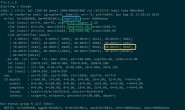C++查看 IEEE 754 浮点数格式
// A simple and practical way to show the format of the IEEE standard
for binary floating-point numbers (IEEE 754) is to use a union, as shown in the following example:
#include <iostream>
#include <basetsd.h>
#include <iomanip>
#include <cstdlib>
using namespace std;
union FloatNum //Here the tag name (FloatNum) is redundant.
{
float fx;//4 bytes variable
long lx;//4 bytes variable
}fn;
union DoubleNum
{
double dx; //8 bytes variable
LONG64 lx; //8 bytes variable
}dn;
union LongDoubleNum
{
long double dx; //12 bytes variable
long lx[3]; // 3 * 4 bytes variable
}ldn;
int main()
{
fn.fx = -118.6253433; //variable assignment declaration statement
//show size of float
cout << "\nsize of float = " << dec << sizeof(fn.fx) << endl;
cout << setprecision(10) << fn.fx << " = 0x" << hex << fn.lx << endl;
dn.dx = 112.6255678; //assign value to a variable
//show size of double
cout << "\nsize of double = " << dec << sizeof(dn.dx) << endl;
cout << dn.dx <<" = 0x" << hex << dn.lx << endl;
ldn.dx = -12.61256125; //assign value to a variable
//show size of long double
cout << "\nsize of long double = " << dec << sizeof(ldn.dx) << endl;
cout << setprecision(10) << ldn.dx << " = 0x" << hex << ldn.lx[2] << ldn.lx[1] << ldn.lx[0] << endl;
return 0;
}




